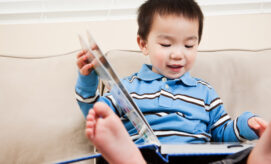As children grow up in increasingly diverse communities, many teachers, parents, and researchers are thinking about the benefits of incorporating a second language into your early childhood curriculum.
Introducing different languages to children supports cognitive and social-emotional development, while also encouraging community building through exposure to different cultures. This practice also has advantages for children who are learning English as a second language, or whose parents speak a different language at home as they hear their teachers and peers speak their native language in the classroom.
Developmental Benefits
According to an article published by The American Council on the Teaching of Foreign Languages (ACTFL), “learning a second language boosts problem-solving, critical-thinking, and listening skills, in addition to improving memory, concentration, and the ability to multitask. Children proficient in other languages also show signs of enhanced creativity and mental flexibility.” Additionally, learning a second language can help set young learners up for later academic success. Children who are bilingual typically have improved reading, writing, and math skills, and they generally score higher on standardized tests when compared to children who only speak one language.
Learning a second language is also beneficial for children’s social-emotional development, by helping children to learn about and better understand different cultures. This helps children to demonstrate more positive attitudes towards those that are different than themselves.
Bringing Native Languages into the Classroom
Children who are learning English as a second language, or whose parents speak another language at home, will benefit from hearing their native languages in their classroom. According to Fountain Magazine, a child’s native language has a powerful impact on identity and formation. The first language heard by the child has an important role in shaping thoughts and emotions. Because language is linked with culture, children hearing their native language as part of the curriculum will connect learning and play to their family, religion and identity.
When we celebrate other languages in the early learning environment, we create a better understanding of the cultural identities of children.
Marketing your Curriculum
Many parents recognize the benefits of being exposed to languages at a young age, and will seek out programs with foreign language(s) as part of the curriculum. Letting parents know that you incorporate both native and other languages into your classroom practices can be a huge selling point for your program.
During tours and interviews, share with parents how you incorporate different languages into your daily routine. When meeting with new parents or families, always ask what language or languages are spoken at home; and talk openly about how you plan to bring that into your curriculum. This will help you and your teaching team develop an understanding of the whole child.
2 Quick Ways to Incorporate Different Languages into Curriculum
-
Using native words in the classroom: For children whose parents speak another language at home, ask their parents about some of the child’s commonly used words. These might include milk, nap, eat, jacket, hello, goodbye, or other words that the child uses often throughout the day. These words can be written out on cards and can be posted in easy to access places around the classroom so that you can quickly peek at them when communicating with the child.
-
Bilingual teaching resources: Canticos World has several bilingual resources for educators, including books that are available for purchase with English and Spanish text and bilingual songs on their youtube channel. Singing and reading are great ways to introduce new languages to children. Preview one of their videos of a Spanish nursery song here:





